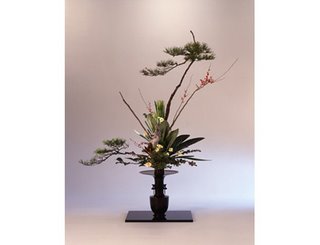A (Very) Short History of Ikebana's Origins

Rikka Style, Ikenobo School
The origins of ikebana are not precisely clear. Its roots reach at least to the introduction of Buddhism to Japan in the 6th Century and the floral temple offerings that accompanied it. Still, it is hard to ignore the influence that Shinto's appreciation of nature had on the development of ikebana.
Indeed, this combination of Shinto and Buddhist influences is visible in the arrangements themselves. Each ikebana arrangement is composed of structure and nature - of formula and variation.
Some authors trace ikebana to the Muromachi (Ashikaga) Period (1338 -1573), during which there was extensive contact with China. It is clear that ikebana flourished during this period, as did many art forms including architecture, tea ceremony, painting and noh theater. (Munsterberg, 77)
This date seems a bit late, however, given that flower arranging and flower viewing were popular with Japanese aristocrats as early as the Heian Period (794 - 1192). Also, the shoin-zukuri style of domestic architecture that was introduced when the samurai seized power in the Kamakura Period (1192 -1333) had as one of its main features an alcove - called the tokonoma - where prized objects, including floral arrangements, were prominantly displayed. There are also accounts of flower-arranging contests being held at the Imperial court from the 13th - 16th century. (www.ikenobo.jp)
The case for the Muromachi date rests on the reputation of the Ikenobo School which is often regarded as the birthplace of ikebana because its systematic approach is considered to have brought deeper meaning to the way in which people approached the arrangement of flowers. Rather than being content with arranging them in a vase, the school says that "an earlier attitude of passive appreciation developed into a more deeply considered approach." (www.ikenobo.jp) It is this change in approach which the Ikenobo School regards as the beginning of ikebana.
A Point to Ponder: The tokonoma is traditionally where a householder would showcase treasured items and things that displayed his good taste.
Is there a place in your home or office that serves a similar function?

6 Comments:
Hmm. Our good taste is probably most shown off on our cd and bookshelves! But we do have one corner set of shelves that is almost entirely art objects, and which is easily seen from most of the dining-room chairs; that is the closest we have to the Japanese equivalent.
It's so interesting that there is an architectural space traditionally set aside in Japanese homes for this sort of thing, given that, if my understanding is correct, they're likely to have considerably fewer square feet of house than we are, to start with. Apparently art has a higher value to many people there than to many people here.
I'm not sure if it's the art that is considered of higher value or the status of having a place set aside to display it. It probably depends on the era being discussed and what class the householder belonged to.
debbie~ I think that a lot of families used to use their front hall/foyer but fewer houses have them these days. Some people use their living room fireplace both for displaying family heirlooms/picture and seasonal decoration.
Both of these use what is essentially part of the "public" part of the home to make a statement about the people that live there.
Any more thoughts?
I'm so intrigued by the thought of an entire 6' x 6' space dedicated to that which is most honored in a culture that values space so highly. We build huge houses, yet rarely have a such a designated space. In our home, our dining room houses our loved objects (some in the china cabinet and some in a book case).
We have our display items either on wall shelves or in a china cabinet. The wall would be an extension of the showcase by hanging pictures. When you have little ones around, everything valuable must be up high!
I've been thinking about this question and I'm not sure where we attempt to showcase our taste in our house. The first thing anyone sees from our door is the bookcase on the upper level. (Fortunately, they don't see the piles of books beside it!) On top of the bookcase are a few pieces of NC pottery and glass and an Eastern Cherokee wood carving. It's not really "displayed", as such.
After this exercise, I'm considering rearranging the items on the top to show them to a better advantage. None of the pieces are valuable but they are all unique.
Post a Comment
<< Home